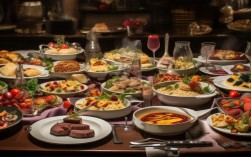Food is a universal language that connects people across cultures. Whether you're a traveler, a student, or simply a food lover, expanding your English vocabulary related to cuisine can enhance your dining experiences and conversations. Below is a carefully curated list of essential food-related terms, categorized for easy learning.

Types of Food
Understanding different food categories helps in describing meals accurately.
- Appetizers (Starters): Small dishes served before the main course (e.g., bruschetta, spring rolls).
- Main Course (Entrée): The primary dish in a meal (e.g., steak, pasta, curry).
- Desserts: Sweet dishes served at the end (e.g., cheesecake, tiramisu).
- Snacks: Light bites between meals (e.g., popcorn, nuts).
- Beverages: Drinks, both alcoholic and non-alcoholic (e.g., juice, wine).
Cooking Methods
Different techniques create unique flavors and textures.

- Grilling: Cooking over direct heat (burgers, kebabs).
- Baking: Using dry heat in an oven (bread, cookies).
- Steaming: Cooking with vapor (dumplings, vegetables).
- Frying: Submerging in hot oil (fried chicken, tempura).
- Boiling: Cooking in hot water (pasta, eggs).
Common Ingredients
Key components used in various recipes.
- Herbs: Fresh or dried leaves for flavor (basil, thyme).
- Spices: Dried seeds or bark (cinnamon, cumin).
- Dairy: Milk-based products (cheese, yogurt).
- Proteins: Meat, fish, tofu, beans.
- Grains: Rice, wheat, oats.
International Cuisine Terms
Exploring global dishes broadens culinary knowledge.

- Italian: Risotto, gnocchi, prosciutto.
- Japanese: Sushi, ramen, miso.
- Mexican: Tacos, guacamole, enchiladas.
- Indian: Biryani, naan, masala.
- French: Croissant, ratatouille, bouillabaisse.
Descriptive Food Adjectives
Words to articulate taste and texture.
- Savory: Rich, umami flavor.
- Crunchy: Firm and crisp.
- Tender: Soft and easy to chew.
- Spicy: Hot from peppers or seasonings.
- Bitter: Sharp taste like dark chocolate.
Dining and Restaurant Vocabulary
Useful phrases for eating out.

- Reservation: Booking a table in advance.
- Menu: List of available dishes.
- Bill/Check: Payment request after a meal.
- Takeout: Food ordered to-go.
- Buffet: Self-service meal setup.
Mastering these terms not only improves communication but also deepens appreciation for diverse culinary traditions. Next time you enjoy a meal, try incorporating these words into your conversations—it makes the experience even more flavorful.



